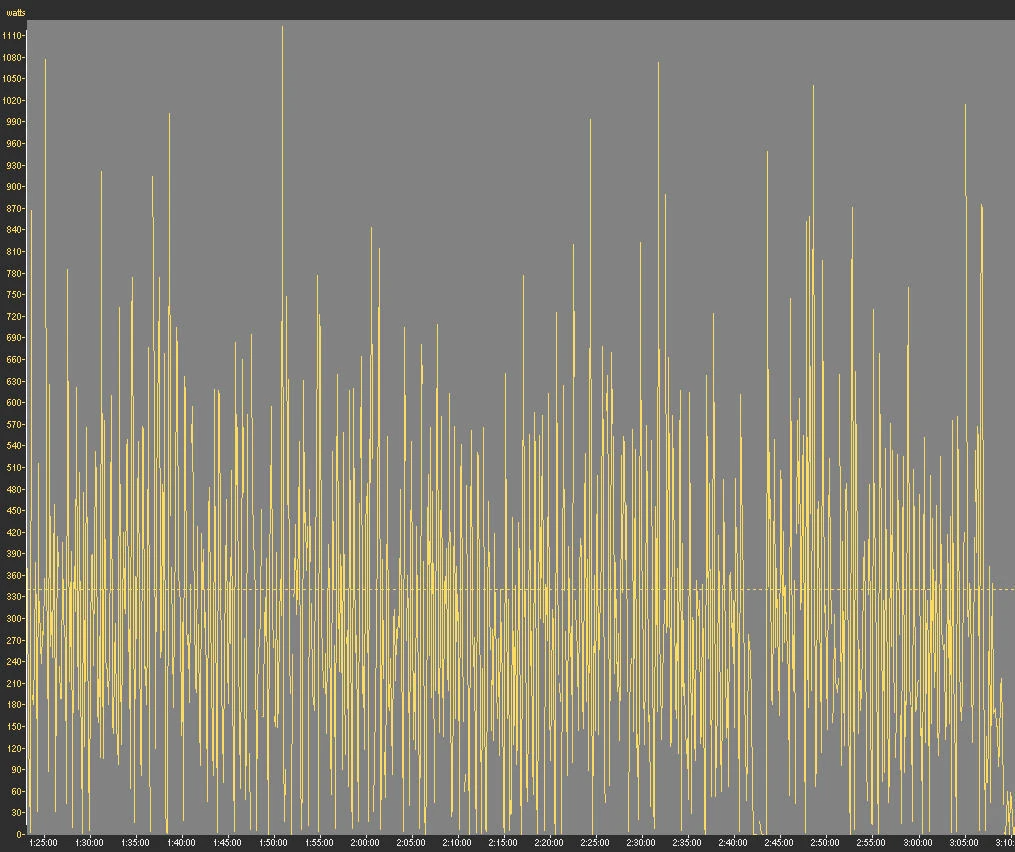Criterium Racing: Watts Up?
Frank Overton
A good criterium racer needs experience and lots of anaerobic power. Being fast and fit is only a part of the equation. Strategy, patience, pack positioning, bike handling and luck are just a few strengths a crafty crit racer possess. SKILLS! While you are gaining that experience with those skills (read about criterium race tactics HERE), you can tailor your training to mimic a criterium with anaerobic intervals for one minute or less, greater than 120% of you threshold power (FTP).
First, it is important to define what actually happens in a criterium in terms of power in order to replicate that power in your training. Without getting into a detailed description, power in watts is to a cyclist, as horsepower is to a Ferrari. At first glance, the graphical power output of a cyclist racing a criterium looks like a bunch of goobly-gook. A typical power file from a criterium spikes up and down several times per lap creating a complicated maze of peaks to the untrained eye. However these short sharp peaks, anywhere from 300-1000 watts or even greater, represent the cyclist sprinting out of corners, accelerating, attacking, counterattacking, and finally the big spike: the field sprint.
Power Graph of Pro 1/2 Downer Avenue Criterium, Superweek July 26, 2008:
Drops in power to zero (a.k.a. Zero Time) represent time spent coasting, setting up for a corner, cornering, or just getting sucked along in the peloton’s draft. Further analysis shows how much time was spent in certain power zones and also how much time was spent at zero power.
The wattage bins below indicate that this racer spent 50% of the race soft pedaling. This athlete ALSO spent 20% of race > 120% of his threshold power aka Zone 6, aka Anaerobic.
There are two power zones critical to successful criterium racing that are often overlooked in a traditional training plan: power above your threshold and zero watts (if that is even a zone). Often times comparison of files between the winner and a pack finisher in the same crit reveals that the winner spent more time at zero! However, when it really counted such as making “the break” or the sprint finish, the winner’s power output dwarfed the pack finisher. Why? Because the winner spent more time at zero, was more rested, and metered his efforts better than the pack finisher. This also goes back to that crafty crit racer thing. Now this may not always be the case (or possible) so in addition to increasing your zero time in a crit, you might also want to consider training at the type of power outputs you’ll need to chase and drop your competitors.
For starters, entering more crits is an ideal way to train which, again, goes back to the crafty crit racing experience thing. In addition, short intervals 5-20 seconds in length at power levels WAY above your threshold mimic criteriums the best. Looking at a power file from a typical crit reveals anywhere from 10 - 80 spikes depending on the course, category, length, level, intensity, and terrain.
Break that down into an interval workout and start with a workout of ten to thirty 5 second sprints (depending on your fitness level).
Now further break up those sprints into sets of 4-6 sprints each. Once again start slowly and work your way up in intensity and number of sets. But you can do it; its just all out for five seconds followed by 15-30 seconds of rest and repeat.
Break up the sets with 5 minutes of rest and you have yourself a great criterium specific mid-week workout. In total a typical workout may be only 2.5 minutes of intensity but its at an intensity much much greater than your power at threshold. We’re talking 300 -1000 watts! The idea is to stimulate your body to be able to handle power outputs of this magnitude on a regular repeated basis. Just what occurs in a criterium.
Here are some other great goto criterium interval workouts: that will increase your anaerobic capacity:
Zone 6: 2 sets of 4 x 30 secs ON 30 sec OFF, FULL GAS, >125% of your FTP, 5 minutes in between sets
Tabatas! 3 sets of 8 x 20 secs ON 10 secs OFF, FULL GAS, > 150% of your FTP, 5 minutes in between sets
As your training progresses, increase the duration of each interval eventually working your way up to 45 and 60 seconds. Similarly, increase the total volume of intensity of the workout up to 10 or 20 more total minutes depending on your fitness level. Before long you’ll be that crafty crit racer coasting along, breathing easy and racking up zero time just waiting to make your move. Now don’t forget to recover by taking your recovery days! Read our recovery for cyclists tip here.
Copyright © 2022 FasCat Coaching - all rights reserved.
Join our *FREE* Athlete Forum to nerd out with FasCat coaches and athletes about your FTP, race data, power based training, or anything related to going fast on the bike.
Unbound Race Recap with Coach Isaiah Newkirk
Ask a FasCat # 18

Foundation : 3 Weeks
- Perfect for all cyclists beginning off season training
- Raise your CTL and the all-important muscle tension intervals

Phil Gaimon's FONDO
- Complete similar workouts to what Phil does to prepare for all his KOM's
- Sweet Spot training, threshold intervals, and some anaerobic work

Phil Gaimon's Strava PR Plan
- Perfect Plan for Those with Less Training Time, starts at 15 minutes per day
- VO2's, 1 minuters, Tabatas, threshold, suprathreshold, and even Sweet Spot

Road Race In-Season
- Weekend racing and group rides with weekday training and recovery
- anaerobic efforts like criss cross, Over/Unders Sweet Spot, Threshold

Road Racing Intervals
- Increase your functional and race-specific power output
- Includes Sweet Spot, VO2, Anaerobic, Threshold













































